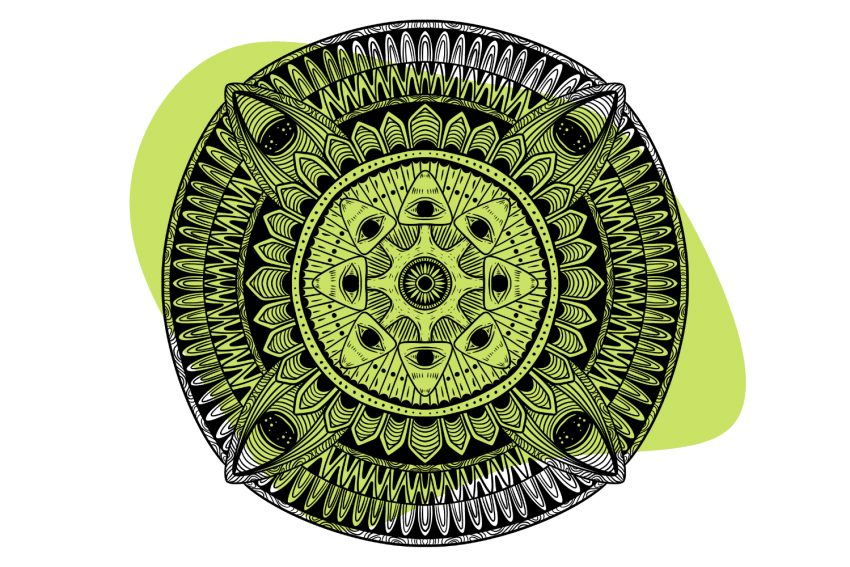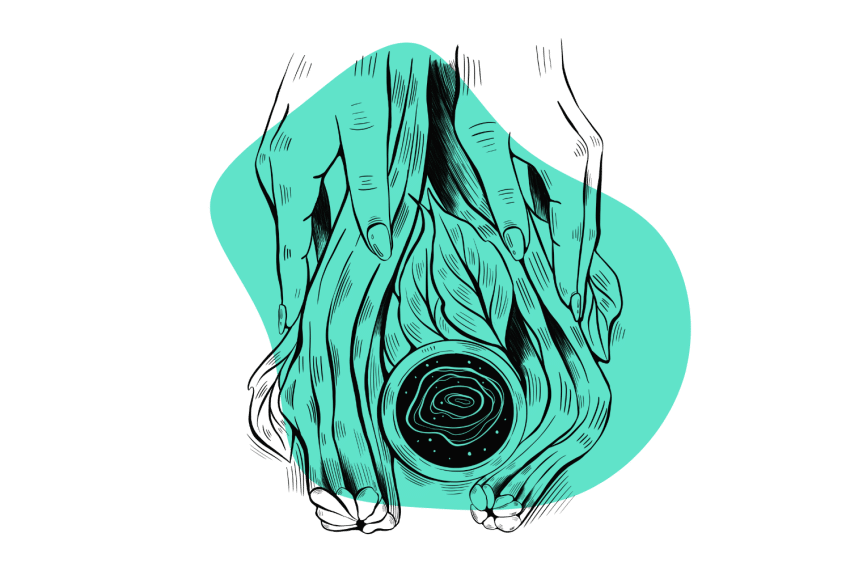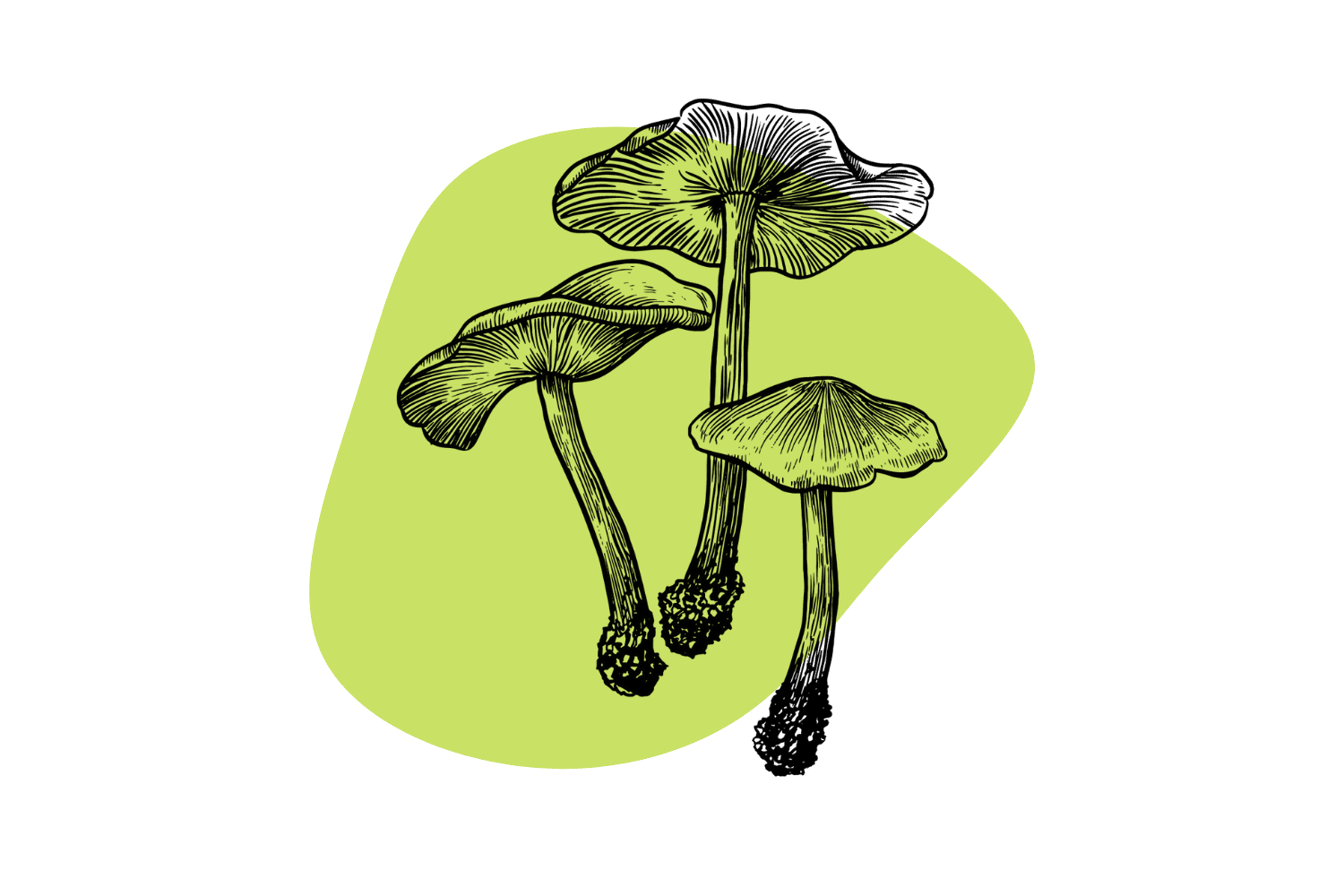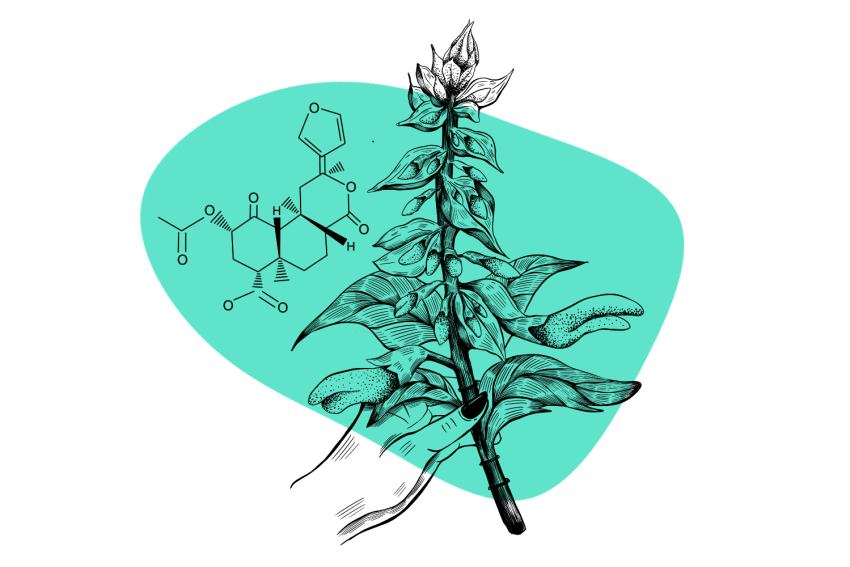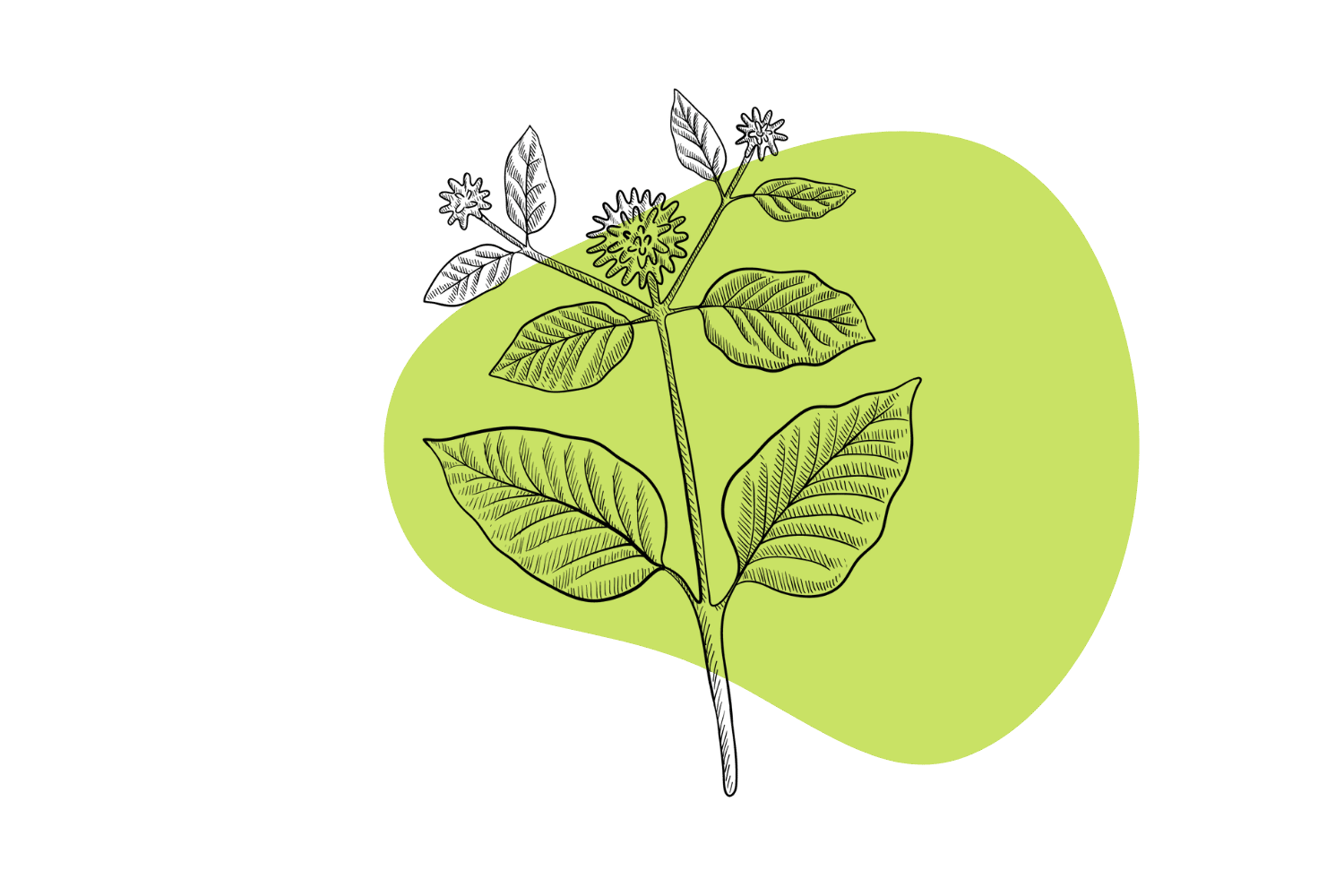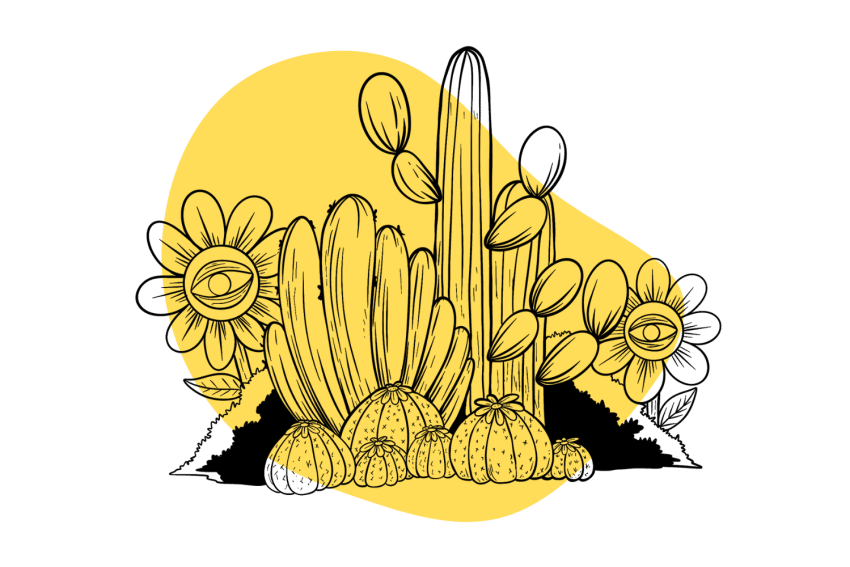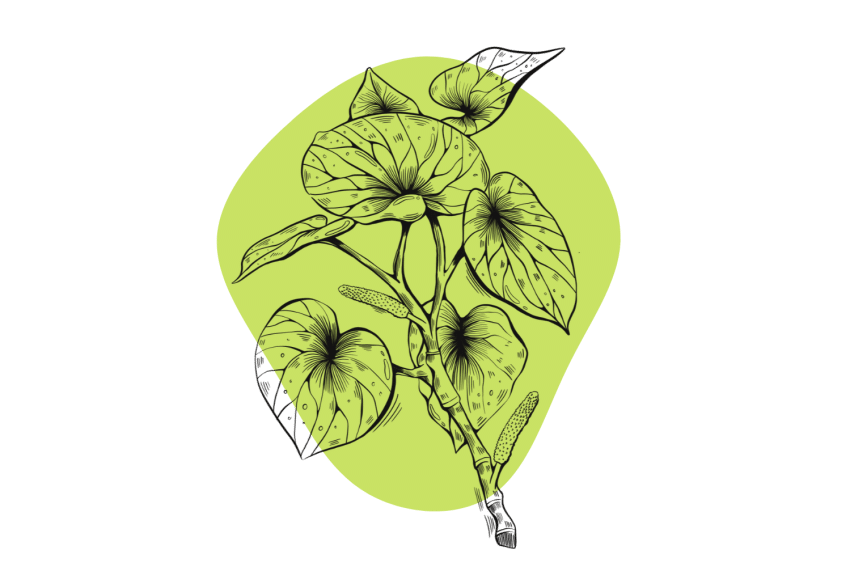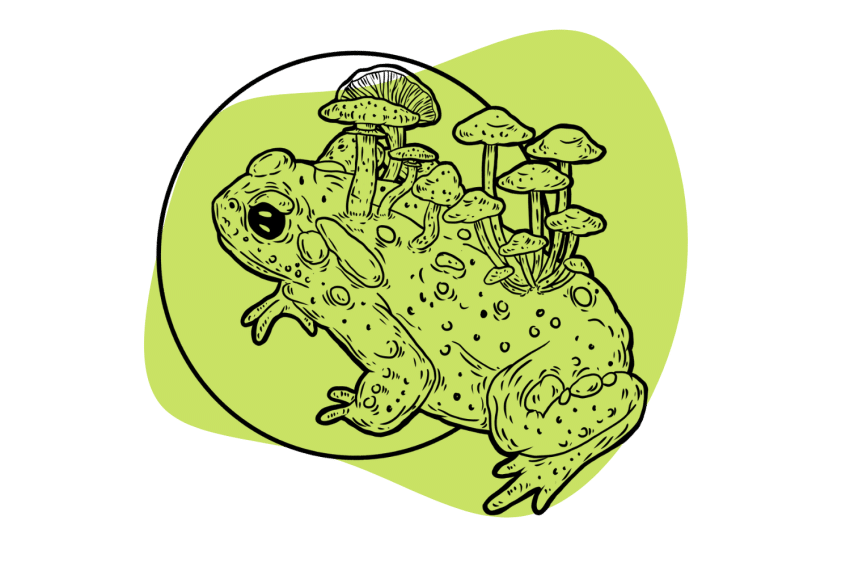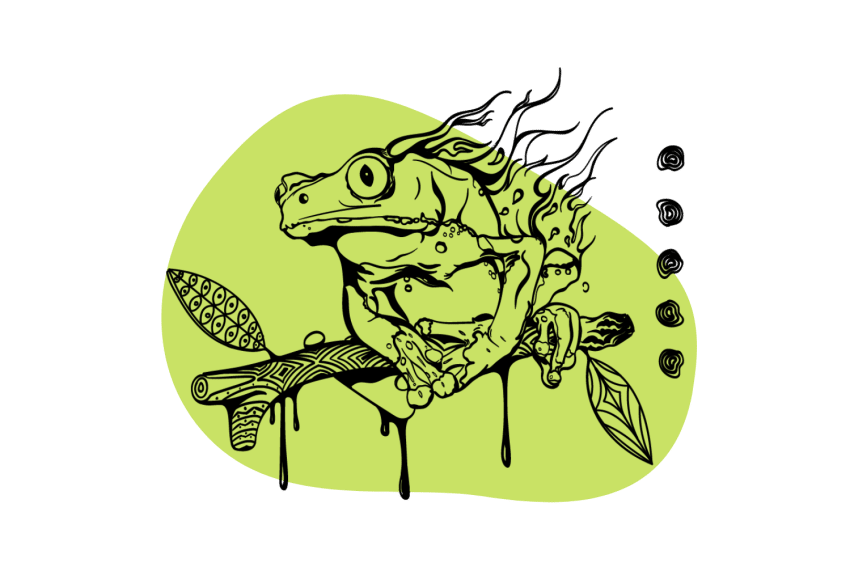Nutmeg: The Psychedelic Spice With A Dark Side
Nutmeg (yes, the common spice in your cabinet) is shockingly psychedelic — and dangerous.
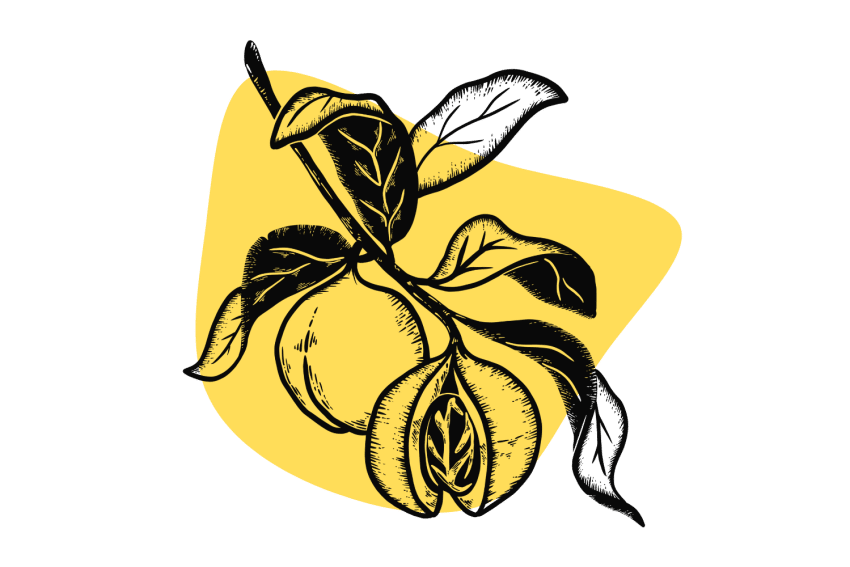
Nutmeg is a spice that screams “Christmas,” but a select few think “deliriant” instead. If you haven’t heard accounts such as the one in Malcolm X’s autobiography, nutmeg can bring a lot more than Christmas cheer.
Often used as a legal alternative to prohibited substances, some fall into the false belief that nutmeg is safe because it’s natural. Many who turn to nutmeg do so because they are looking for a legal high.
Smoking nutmeg produces intense hallucinations and induces a state of delirium — surprising for such a common culinary spice.
Right up front, we’ll throw out there that nutmeg is not safe to consume recreationally, and we do not recommend trying it.
What Is Nutmeg?
The nutmeg tree (Myristica fragrans) is one of 150 species of the Myristica genus of trees. These evergreen trees come from Indonesia but spread broadly across tropical countries in Asia and South America.
This tropical evergreen tree blooms in the spring but will not grow in colder environments with a winter season (or even a harsh fall.) Its typical climate ranges from 77-86℉, making it very hard to grow anywhere within the United States.
The tree produces a smooth, yellow fruit that cracks open when it’s ripe, exposing the red casing on the brown seed inside. This seed is what we typically call “nutmeg.”
The History of Nutmeg
Nutmeg has a long and fabled history with tales of brutal genocide and textbook human greed. It starts with the Banda Islands in Indonesia — at the time, this was the only place Europeans knew of where nutmeg grew.
The Portuguese “discovered” nutmeg — a spice that an entire indigenous society was already using — on this island in 1512. This marked the exploration of the Portuguese crew’s success in their goal of finding the next new spice for the world.
After they left, however, the Dutch would arrive at the “Spice Islands” and seize them. These seizures of entire communities are only possible through violence.
In stereotypical human fashion, the Dutch cornered the people of these islands and brutally murdered them. Some reports indicated the Dutch herded several indigenous people to fall from the cliffs on the very island they were having ripped away from them.
As for the rest, the armies got to work and beheaded, tortured, and otherwise killed off 90% of the island’s residents. The result was a virtual monopoly on the spice, which was mostly only obtainable by the elite.
But this didn’t last.
After some successful smuggling attempts, nutmeg was able to escape this island as people successfully planted it elsewhere around the world. As it began cropping up elsewhere, the market loosened, and nutmeg eventually became the staple spice we know it as today.
Traditional Uses of Nutmeg
Many conditions would lead indigenous cultures to turn to this spice. Namely, they believed nutmeg could treat the following [1]:
- Anxiety
- Cholera
- Chronic vomiting/nausea
- Cramps
- Hemorrhoids
- Psychosis
- Rheumatism
Other traditional use of nutmeg includes treatment for flatulence/gastrointestinal distress, diarrhea, and indigestion. Lesser-reported uses could include the treatment of tumors and diseases as well as psychological disorders [2].
To back this up, there is some current research indicating the potential benefits of nutmeg may include the following properties [3]:
- Anti-inflammatory
- Analgesic (pain-relieving)
- Antithrombotic (reducing the formation of blood clots)
Bear in mind that none of these use a “recreational” dose of nutmeg — the kind you might use for a legal high. At those levels, nutmeg takes on a very sinister character.
This is where people start having to tangle with the dangerous side of the drug.
Is Nutmeg Hallucinogenic?
Nutmeg is hallucinogenic but in a different way than you’d expect with a classical psychedelic. The active ingredients, myristicin and elemicin, are potent deliriant drugs with effects most comparable to datura, brugmansia, or belladonna.
However, unlike these other plants, nutmeg’s active ingredients are classified as amphetamines rather than tropane alkaloids. The psychedelic effects of nutmeg are unique in and of itself — displaying qualities of both amphetamine stimulants and deliriant tropane alkaloids.
Delieriant hallucinations are more like dreams that you act out instead of a trance that you can observe. The desire to act out the delusions you’re experiencing makes everything much more dangerous for obvious reasons. Users in a state of delirium don’t know they’re hallucinating.
Or, to put it another way: hallucinogenic drugs might make patterns move in a way that looks like bugs crawling around, but deliriants will manifest as actual bugs crawling out from the floorboards.
These hallucinations have common themes like having conversations with people that aren’t there, smoking cigarettes that don’t exist, as well as more sinister experiences.
How to Take Nutmeg
The main way people ingest nutmeg is orally, often preferring fresh, whole nutmeg as opposed to powder. Some have tried smoking it as well but often find it has little effect.
Nutmeg is an unpleasant experience whether you taste it orally or through the smoke. Don’t expect it to taste like eggnog.
Nutmeg Trip Reports
Here are a few reports of people who have taken nutmeg and what their experience was like:
A Case Study from 1968:
“… About two hours later, he first experienced great thirst. Yet, when he saw water, he seemed afraid to drink it. After drinking one-half glass of water, all objects in the room seemed to be swaying slightly. Color of objects seemed deeper, and he seemed to be swaying. He thought these conditions were unreal, yet he felt they were happening at the same time. Confused, he went to bed and pulled the pillow over his head, but he was too restless to stay in this position long because he felt “so hot.” Then he seemed as though he had to lift his legs higher as he walked. Gradually he realized he did not know what he was doing. He called his wife, who called some of his friends to stay with him and to help, if necessary, because she had become frightened.
At this stage, he appeared nauseated and talked incessantly. At intervals, he seemed quite happy, elated, and amorous and, every now and then, stopped as though he was listening to something. By this time, he reported being “light-headed,” as if floating, with some vague abdominal pains. This experience had now gone on for several hours. At this stage, he was given some weak salt water to make him vomit since it was believed that he had been drinking, and this might help as a gastric lavage. He stated that he was told that he did not vomit but soon fell into a heavy sleep. He awakened about six hours later with a strange feeling as if he were not quite real as if he had been in a “trance.” For the next eight hours, he felt that he wanted to cry but could not. He became depressed and slowly drank some warm milk. He showed evidence of tremors some 48 hours later but gradually felt better.” [7]
“Exceeded My Expectations” From the Erowid Vaults
Dose: 5g smoked, unknown amount oral
“I rolled about 5 grams or idk into a fat ass smoke where I would spend the next 5 minutes regularly puffing the nutmeg cigarette. It was definitely not pleasant to smoke. It didn’t burn well and felt terribly dry in the throat. I waited it out and nothing happened. There were no noticeable effects, so I decided to eat the rest, which was much worse than smoking.
It was like eating sand, and it couldn’t be stirred into any liquid. Eventually, after a painstakingly long time of forcing this shit down my throat, I managed to complete it all. However nothing ended up happening that night, so I gave up and went to sleep. The next morning when I woke up I was more tired than usual, but I brushed it off, that was until I looked into the mirror. My eyes were unusually red.
They’re usually red when I get up, but I never look stoned, which I later realized I was… I was in fact high on nutmeg. It was like being drunk and stoned at the same time. My thought process was that of a drunk person, my coordination was pretty bad, it was difficult to maintain balance, my body felt as though it was swaying … I was in this state all day, from when I woke up to when I went to sleep.
It did start to mellow down as the day went past, but I was still high at the end of it. In conclusion, it’s like being stoned and drunk at the same time, and it lasted all day. I’m not sure what got me high, whether it was smoking it or eating it, but I tried only eating later with absolutely no side effects.
“Nutmeg…..dizzy for 5 days straight” From the Erowid Vaults
Dose: 2 Tbsp Nutmeg Powder
7:00 pm…. I tried going to sleep around 7 and I remember laying in bed and looking down, I felt like I was 10 feet tall!!!! But my body was very relaxed and my mind was racing. (Kinda like acid with no visuals) It wouldn’t stop. So I blasted my music and tried shutting my lids. With the tv on in the darkness, I could see the colors seeping through into my eyes and it was really beautiful, but that was about it…no ‘hallucinations’. I remember having a series of really crazy dreams but I don’t think those count as ‘visuals’.
Tuesday (Next Morning)…. I woke up feeling buzzed which was fine with me, I mean I didn’t have a horrible ‘hangover’ like I was reading about and I was grateful. But the worst was yet to come…
Wednesday (Next Next Morning)…. I woke up feeling dizzy. I had horrible spins and a throbbing headache. My eyes hurt so bad I could barely keep them open….I continued feeling like this all that day. I remember going to bed hoping to GOD that this would be gone the NEXT morning….NOPE.
Thursday (Next Next Next Morning)…. I woke up with no headache and my eyes didn’t hurt as much but I was sooooo dizzy. Just plain dizzy for the whole day. And I mean I remember feeling like ‘WHEN’ will this go away??? Cuz I kept waking up and the buzzing dizzy feeling was still there. I took some ibuprofen, but I just got a big stomach ache. OUCH. I hated not having control of this feeling. It was horrible!!!!!
Friday …. I woke up and I wasn’t dizzy!!!! WRONG!!!! As soon as I stood up, my head started to spin again. I was so sick of this shit that I downed about a quarter of a bottle of straight vodka to get rid of the horrible hangover. WRONG move. I woke up the NEXT morning with an even WORSE hangover and more of the spins.
My advice to anyone even contemplating nutmeg is NO NO NO. I mean the first day was pleasant, but I was expecting good visuals (which were practically non-existent) and the rest of the week was just plain ruined for me.
The Dangers of Nutmeg Intoxication
In ordinary doses reserved for spicing food or traditional remedies, nutmeg is safe. However, many abuse the spice in large doses to achieve a legal hallucinogenic effect.
At these larger quantities, the potential for nutmeg to cause harm is much greater. The LD50 of nutmeg — or the amount you would have to consume to be at major risk of dying from it — is quite high but not unattainable. When people use tinctures or extracts or smoke the herb, this becomes much more possible to reach.
Typical doses range from 5-30 g of ground nutmeg — with 50 mg or above being highly toxic — but several poison control cases will show that even this amount isn’t always safe [4]. From psychological issues to physiological problems, problems seem to be possible whenever using anything over 5 g of nutmeg.
Side Effects of Nutmeg
Alongside the hallucinatory effects of nutmeg, users can expect a broad range of unpleasant effects. While you may not feel all of these effects, some mixture of them will likely occur.
Possible side effects of nutmeg may include:
- Delirium
- Dizziness
- Dry mouth
- Irregular heartbeat
- Irritability
- Loss of consciousness
- Nausea
- Respiratory failure
Others have reported experiencing memory loss or feelings of psychosis after using nutmeg. It’s worth noting that these effects often extend beyond the actual effect of the drug. Some even report them lingering for days or weeks in extreme instances.
Hepatoxicity & Nutmeg
One of the most dangerous elements of nutmeg lies in its hepatotoxicity — or toxicity in the liver. One study found that repeated or long-term exposure to nutmeg was directly correlated with liver damage [6].
The conclusion of this article states that the liver may even be “the target organ affected by nutmeg abuse in duration.” Our liver has a remarkable capability to repair itself from things we do to poison it every day — like drinking alcohol.
The problem here comes from repeated or large doses that may stop the liver from returning to standard function. In these cases, the liver damage may exceed repair or stop functioning altogether.
Physical Dangers of Nutmeg Intoxication
Like all hallucinogenic and dissociative drugs, nutmeg has mixed reviews online. While the majority of them lean on the side of not being worth the side effects, nutmeg is not without its proponents.
One of the biggest risks is the potential for intentional or unintentional self-harm due to intoxication. This is exceedingly rare and often overblown as a scare tactic, but it is a real possibility.
If you are going to experiment with nutmeg, it’s crucial to have a trip sitter that will be sober and stay with you. You shouldn’t be the person that’s in charge of keeping yourself out of trouble.
Drugs that act as deliriants are not the same as hallucinogens. The biggest difference between the two is that a deliriant drug is likely to lead to the user trying to act out the delusions they experience.
Mental Dangers of Nutmeg Intoxication
For many, the high that comes from heavy nutmeg consumption is not pleasant. It can often lead to paranoia — even to the point of dread and fear.
Even if that’s the whole story and you go back to normal 20 hours later, that effect can linger. It’s hard to recover from existential dread and the fear of life itself.
Some have found themselves with new trauma as a result of unpleasant experiences with psychedelics. This may even manifest as PTSD (Post-Traumatic Stress Disorder.)
With nutmeg, it seems the bad experiences often outweigh the good ones, meaning these experiences are more likely. Do not experiment with nutmeg if you are in a vulnerable or mentally unwell state.
Has Anyone Ever Died from Nutmeg?
There are two instances of people consuming nutmeg and dying from it, both with some extenuating circumstances.
Of the two deaths, one comes from a report in 1908 involving the tragic death of an 8-year-old boy after ingesting just “two whole nutmegs” [5]. This would be well below the 50 mg amount, even adjusting for his age.
Given the length of time, since this happened, there is very little information available, so it’s a shaky case study. Additionally, the youth of the boy in question means that it doesn’t necessarily mean anything to adults.
The other case involved a woman who passed away after consuming nutmeg in conjunction with a fatal dose of the benzodiazepine drug flunitrazepam. This suggests it was likely the harmonious effort of the two substances that led to the tragic death.
It seems as though the deadliness of nutmeg is not as high as many like to claim it to be. However, it’s still not safe to consume. There are very real problems that can arise from consuming recreational levels of nutmeg.
Nutmeg’s Active Ingredients
There are two primary active ingredients in nutmeg — myristicin and elemicin. While the actual mechanism by which nutmeg becomes toxic is not yet fully understood, these two chemicals seem to be the main culprits [8].
Both of these compounds have a hallucinogenic and potentially toxic quality on their own.
Myristicin
This naturally occurring compound has several fascinating properties that give it the hallucinogenic properties people experience when taking nutmeg. This compound is an amphetamine and a weak monoamine oxidase (MAOI) enzyme inhibitor [9].
Among many other effects, inhibiting the monoamine oxidase enzyme slows the breakdown of serotonin and serotonin-like molecules. This is the same effect that another drug (harmala alkaloids) uses to enable DMT (dimethyltryptamine) to be orally active, providing a critical element of ayahuasca and psilohuasca.
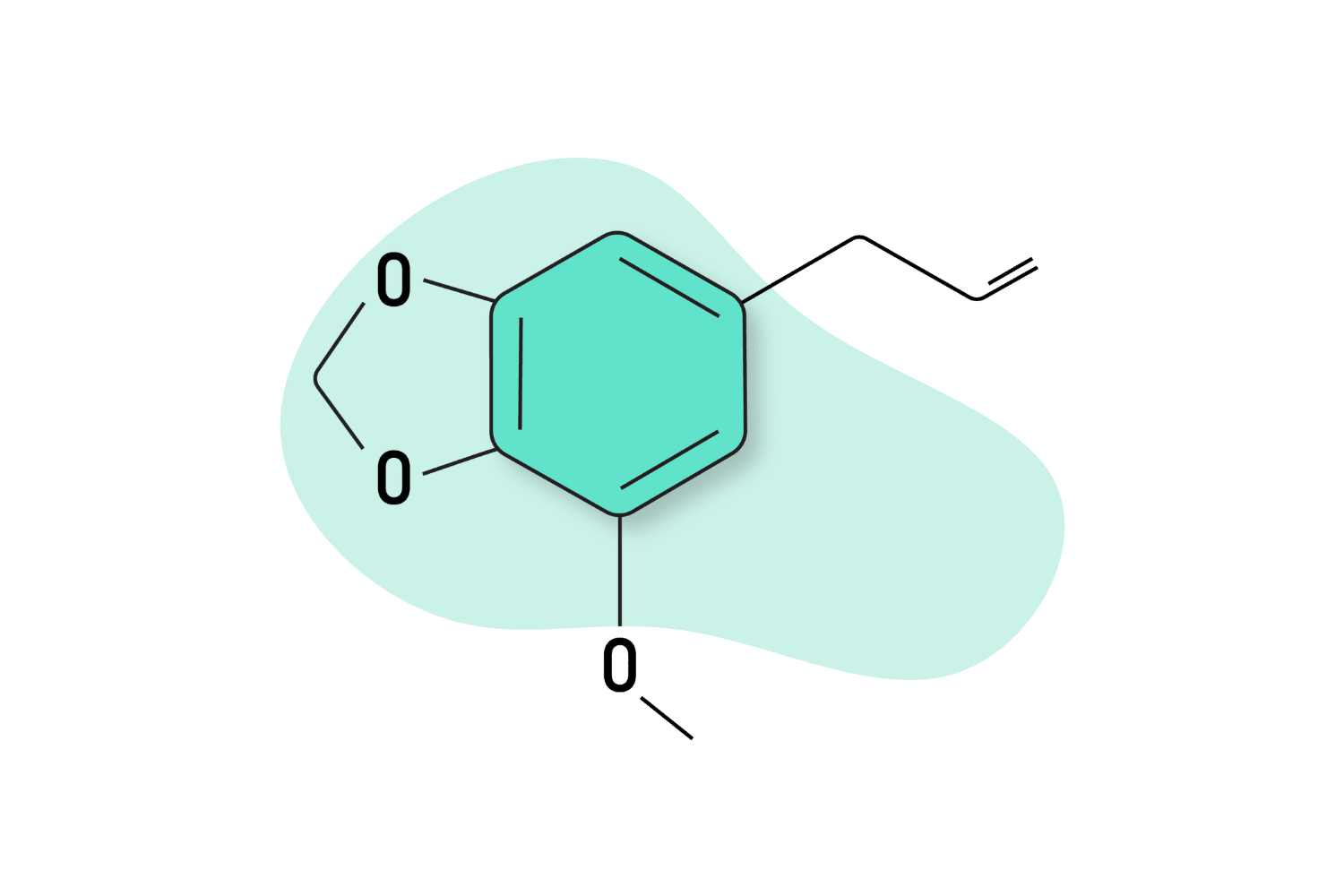
In this instance, the weak MAOI effect could potentiate the other effects of the drug or provide a mild antidepressant quality.
The amphetamine component of myristicin has caused some to compare its effects of it to MDMA. While this is an interesting similarity, that’s pretty much where the commonality ends.
The effects of myristicin are very different from that of MDMA — both in effect and in duration.
At high doses, this compound is toxic to the neurological system, and though the LD50 (lethal dose that kills 50% of the test subjects) is not known, we’d advise high caution when dealing with this substance.
That doesn’t mean there isn’t a bright side to myristicin, however.
This compound has several benefits, including anti-inflammatory, antibacterial, antimicrobial, anti-insecticidal, antifungal, and analgesic activity [13].
Elemicin
Very little research into this molecule currently exists, but it’s reasonable to assume it to be relatively similar to myristicin in terms of effects. This compound also metabolizes into amphetamine components with hallucinogenic properties and is likely just as toxic.
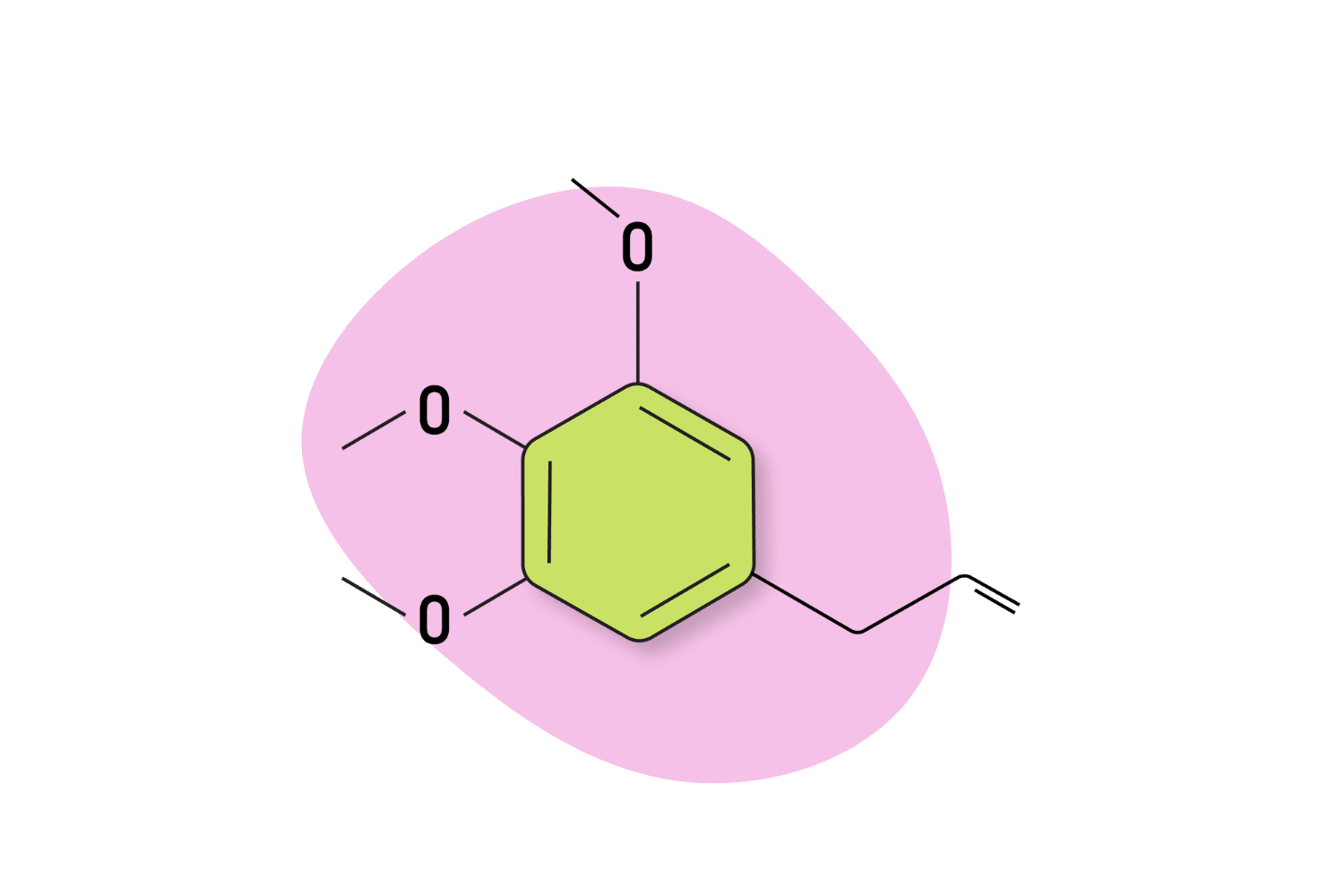
One recent study showed that CYP1A1, CYP1A2, and CYP3A4, were responsible for elemicin’s metabolic activation, which plays a critical role in its cytotoxicity [11].
Isolated elemicin also exhibits strong antioxidant, antibacterial, and antifungal activity — it showed strong activity against E. coli, Pseudomonas aeruginosa, Salmonella typhi, Klebsiella pneumonia, and Staphylococcus aureus [12].
Nutmeg & the Endocannabinoid System
In addition to the benefits mentioned above, nutmeg’s effect on the endocannabinoid system brings other possibilities. Interestingly, this effect does not come from elemicin or myristicin.
While the two compounds we discussed above have little effect on the endocannabinoid system, at least three others do [10]. These are licarin A, 5-methoxylicarin A, and malabaricone C — with 5-methoxylicarin A having the greatest effect.

This could potentially explain the effect of nutmeg, which many describe as being similar to cannabis. Malcolm X, for example, said a matchbook of it was the equivalent of “three or four reefers.”
Combining this with the hallucinogenic, amphetamine qualities of the components above contributes to the total intoxicating effect of nutmeg.
How to Take Nutmeg
Before deciding to take nutmeg recreationally, we again would like to warn you of the potential risks involved and advise you against it.
There is often a misconception that a drug being legal or widely available means that it’s safe to use. In the case of nutmeg, this is absolutely false. Taking large doses of nutmeg carries a potential for health risks that can lead up to hospitalization or even death.
The effects of nutmeg are long-lasting and often described as very unpleasant. That said, some have enjoyed their time with nutmeg and even learned to work with it in a safe, reliable way.
Ultimately, no matter what substance you’re using, the most important thing you can do is arm yourself with information. If you decide you’d like to try nutmeg recreationally, you should first make sure to know what to expect.
With that in mind, here’s a little information on what you can expect when dealing with this spice:
What’s the Dose of Nutmeg?
The right dose will depend on the form you’re using and the effect you want to have. Like many other drugs, the effects of nutmeg are exceptionally dose-dependent, with vast differences in effects with each increase in dosage.
This is not the same as a drug like alcohol, which will only make you drunker as you take more. Nutmeg can have completely different effects based on dosage.
Remember that the information below is general and doesn’t necessarily apply to everyone. Depending on your specific metabolism and physiology, more or less nutmeg may go into the effects you want to achieve.
It’s always best to start low and figure out your dosage gradually over time. As the adage goes — you can always take more, but you can’t take less.
Start off on the low side and plan on taking a few sessions to know exactly what dose is right for you. While it’s tempting to jump right in, this can lead to major complications.
| Source | Light Oral Dose | Common Oral Dose | Strong Oral Dose | Heavy Oral Dose |
| Nutmeg Powder | 5–15 g | 16–20 g | 21–30 g | 31 g+ |
| Whole Nutmeg | 2–5 g | 6–15 g | 16–20 g | 20 g+ |
| Myristicin Extract | 50–200 mg | 201–500 mg | 501–800 mg | 801 mg+ |
Exceeding the amounts in this table would be extremely dangerous, and even “heavy dose” options are very risky.
What Does Nutmeg Feel Like?
Some of the positive effects people utilizing nutmeg may experience include:
- Color enhancement
- Euphoria and giddiness
- Hallucinations
- Increase in ability to taste
- Stimulation and aphrodisiac qualities
- Time distortion and sound distortion
- Warm, pleasant bodily sensations
The negative effects far outweigh the positive and include the following:
- Amnesia
- Appearance of shadow-figures
- Dehydration/dry mouth
- Dizziness
- Double vision, tracers, and other visual distortions
- Frequent urination/difficulty urinating
- Inability to control motor function
- Nausea
- Paranoia
- Psychosis
- Thought disorganization
- Vasodilation and decrease in blood pressure
In addition, there is a potential for effects to last beyond the experience itself.
These long-term effects can include conditions like:
- Anxiety and paranoia
- Constipation
- Fatigue
- Nausea
- Sensitivity to light
- Stomach bloating and cramping
- Suppression of appetite
Dangerous Drug Interactions With Nutmeg
While it’s dangerous enough on its own, the combination of nutmeg with certain medications can prove fatal. One of the two deaths that involved nutmeg also included a large dose of a benzodiazepine, which acted synergistically and led to respiratory depression.
Some of the drugs that you should not take in combination with nutmeg include:
- Alcohol — Combining the respiratory depressant of alcohol with the effects of nutmeg can cause troubling side effects.
- Benzodiazepines — These operate in similar ways to alcohol with much stronger mechanisms, increasing the risk of respiratory depression even further.
- Stimulants — Nutmeg is already a stimulant and vasodilator, so it’s not wise to place more stress on the cardiovascular system.
- Serotonin Modifiers and Serotonigenic Drugs — The MAOI effect of nutmeg increases the risk of problems associated with not breaking down serotonin. In extreme cases, this may lead to serotonin poisoning or even death.
- Dextromethorphan (DXM) — This combination also runs a risk for respiratory depression.
Since there is not an abundance of research into the effects of nutmeg when used in recreational quantities, it’s generally wise to avoid it altogether. This is especially true if you are taking medication, as nutmeg’s influence on it may be unknown.
Criminalization & the Use of Dangerous Alternatives
The report of two case studies from 1968 we reference above starts with a major hint as to the reasoning for people turning to nutmeg. It says:
With the increasing cost and difficulty of procuring heroin and the fear of its use, many in recent years who desire to use drugs to produce a ‘kick’ resort to other substances. Among those allegedly utilized have been nutmeg, banana peel, glue, LSD, and “aspirin and coke with gin.”
Putting aside the fact that the report mentions two fake drugs — one of which was a hoax recipe for smoking banana peels — the reasoning is sound. People can’t get the drug they’re looking for, so they settle for a worse one, which is less enjoyable.
Criminalization has often led to people seeking out their high from less safe means. There is a reason why Malcolm X spoke of the popularity of the drug in prison.
When cut off from a drug of choice — especially one like heroin or alcohol, which can be deadly in its withdrawal symptoms — people are likely to turn to anything they can. For those replacing weed with nutmeg, I would imagine very few would consider it to be a better alternative and would gladly go with the safer option if possible.
Nutmeg FAQ
Is Nutmeg a Hallucinogen?
Myristicin is the chemical within nutmeg responsible for causing its effects in large doses. In higher amounts, nutmeg has deliriant effects, causing users to experience hallucinations that feel more like a dream.
In small doses, nutmeg is perfectly safe and non-intoxicating.
Is Nutmeg Dangerous?
Nutmeg is likely poisonous in large doses due to the toxic side effects of myristicin and other chemicals within nutmeg. There are no current examples of death as a result of consuming nutmeg, but the mental danger and the potential for self-harm while delirious are worth consideration.
What Makes Nutmeg Intoxicating?
Myristicin and elemicin are the primary compounds within nutmeg responsible for its activity. These molecules are psychedelic but contain potentially toxic components in their metabolites that could be partially responsible for the dangers of nutmeg.
For the most part, it’s best to keep nutmeg in the spice cabinet and use it as needed for cooking and baking. While deaths are extremely rare, they are not impossible, and it’s important to make sure that you are mindful of your dose.
Why Do People Take Nutmeg?
Some people genuinely enjoy their experiences with nutmeg — often comparing the high to weed or alcohol. Still, with such a large amount of negative trip reports online, it’s obvious that the main reason for nutmeg use is the criminalization of other drugs.
Is Nutmeg Worth the High?
Some people genuinely enjoy the experiences they’ve had with nutmeg, but the side effects can make it very unlikely to be worth it. Putting aside the fact that the “trip” is rarely even enjoyable, there are some serious physiological problems to battle.
References
- Gupta, A. D., & Rajpurohit, D. (2011). Antioxidant and antimicrobial activity of nutmeg (Myristica fragrans). In Nuts and seeds in health and disease prevention (pp. 831-839). Academic Press.
- Abourashed, E. A., & El-Alfy, A. T. (2016). Chemical diversity and pharmacological significance of the secondary metabolites of nutmeg (Myristica fragrans Houtt.). Phytochemistry Reviews, 15(6), 1035-1056.
- Olajide, O. A., Ajayi, F. F., Ekhelar, A. I., Awe, S. O., Makinde, J. M., & Alada, A. A. (1999). Biological effects of Myristica fragrans (nutmeg) extract. Phytotherapy Research: An International Journal Devoted to Pharmacological and Toxicological Evaluation of Natural Product Derivatives, 13(4), 344-345.
- Hayfaa, A. A. S., Sahar, A. M. A. S., & Awatif, M. A. S. (2013). Evaluation of analgesic activity and toxicity of alkaloids in Myristica fragrans seeds in mice. Journal of pain research, 6, 611.
- Ehrenpreis, J. E., DesLauriers, C., Lank, P., Armstrong, P. K., & Leikin, J. B. (2014). Nutmeg poisonings: a retrospective review of 10 years experience from the Illinois Poison Center, 2001–2011. Journal of medical toxicology, 10(2), 148-151.
- Cao, Z., Xia, W., Zhang, X., Yuan, H., Guan, D., & Gao, L. (2020). Hepatotoxicity of nutmeg: A pilot study based on metabolomics. Biomedicine & Pharmacotherapy, 131, 110780.
- Williams, E. Y., & West, F. R. E. D. (1968). The use of nutmeg as a psychotropic drug. Report of two cases. Journal of the National Medical Association, 60(4), 289.
- Smith, M. (2014). Nutmeg.
- Seneme, E. F., Dos Santos, D. C., Silva, E. M. R., Franco, Y. E. M., & Longato, G. B. (2021). Pharmacological and therapeutic potential of myristicin: A literature review. Molecules, 26(19), 5914.
- El-Alfy, A. T., Abourashed, E. A., Patel, C., Mazhari, N., An, H., & Jeon, A. (2019). Phenolic compounds from nutmeg (Myristica fragrans Houtt.) inhibit the endocannabinoid-modulating enzyme fatty acid amide hydrolase. Journal of Pharmacy and Pharmacology, 71(12), 1879-1889.
- Wang, Y. K., Yang, X. N., Zhu, X., Xiao, X. R., Yang, X. W., Qin, H. B., … & Li, F. (2019). Role of metabolic activation in elemicin-induced cellular toxicity. Journal of agricultural and food chemistry, 67(29), 8243-8252.
- Al-Qahtani, W. H., Dinakarkumar, Y., Arokiyaraj, S., Saravanakumar, V., Rajabathar, J. R., Arjun, K., … & Appaturi, J. N. (2022). Phytochemical and biological activity of Myristica fragrans, an ayurvedic medicinal plant in Southern India, and its ingredient analysis. Saudi Journal of Biological Sciences, 29(5), 3815-3821.
- Seneme, E. F., Dos Santos, D. C., Silva, E. M. R., Franco, Y. E. M., & Longato, G. B. (2021). Pharmacological and therapeutic potential of myristicin: A literature review. Molecules, 26(19), 5914.

